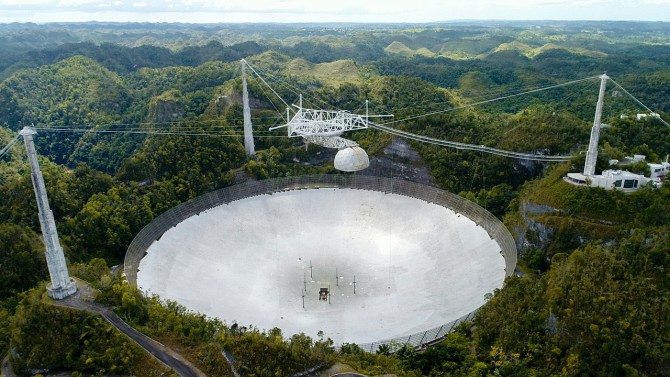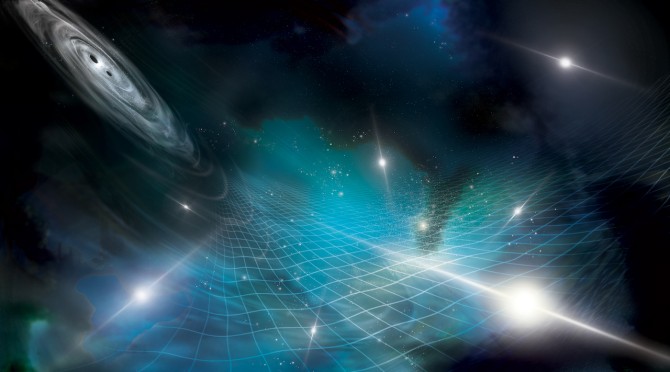A 15-year collaboration in which Cornell astrophysicists have played leading roles has found the first evidence of gravitational waves slowly undulating through the galaxy, ripples in space-time likely generated by pairs of supermassive black holes in the process of merging.
The North American Nanohertz Observatory for Gravitational Waves (NANOGrav) Physics Frontiers Center had previously reported hints of the low-frequency waves predicted by Einstein's theory of general relativity, but said the signal was too faint to confirm their existence.
In research published June 28 in The Astrophysical Journal Letters, the team of nearly 200 scientists and 80 partner institutions said its 15 years of observations with radio telescopes and a collection of cosmic clocks - rapidly spinning pulsars - now provided compelling evidence of gravitational waves with oscillations lasting years to decades.
The National Science Foundation's 305-meter diameter Arecibo telescope in Puerto Rico, which collapsed in 2020, was for decades the largest and most sensitive radio telescope in the world, and accounted for about half of NANOGrav's gravitational wave sensitivity.
The detection and ongoing measurements are expected to advance understanding of the universe's evolution on large and small scales, from insights about how often galaxies collide and what drives black holes to merge, to the fundamental nature of gravity, according to Cornell experts.
"We're opening up a whole new avenue of astrophysics exploration that we could not probe before with electromagnetic waves," said Shami Chatterjee, Ph.D. '03, research professor in the Department of Astronomy in the College of Arts and Sciences (A&S); principal research scientist at the Cornell Center for Astrophysics and Planetary Science (CCAPS) and Carl Sagan Institute (CSI); and chair of NANOGrav's working group leading searches for pulsars. "It's a long-sought milestone."
The newly detected gravitational waves differ from the fleeting, high-frequency ones detected in 2015 by the Laser Interferometer Gravitational-wave Observatory (LIGO), which were created by the collision of black holes 30 times as massive as the sun. In contrast, the low-frequency waves are thought to be generated by orbiting pairs of the universe's most massive black holes - millions or billions of times more massive than the sun, with sizes larger than the distance between Earth and the sun.
"These are giant monsters, and there was dispute about whether they actually existed," said James Cordes, the George Feldstein Professor of Astronomy in A&S and a member of CCAPS and CSI. "We've also demonstrated that these massive black holes in the centers of galaxies can get close enough to emit gravitational waves, as they approach and spiral around each other faster and faster. That process also was disputed."
Supported by the National Science Foundation, NANOGrav collected data with the Arecibo Observatory in Puerto Rico - which Cornell operated for decades, prior to its collapse in 2020 - Green Bank Telescope in West Virginia and the Very Large Array in New Mexico. The ground-based observatories measured pulses of radio waves generated by a network of 68 pulsars located within a few thousand light years of Earth. Spinning hundreds of times per second, the so-called millisecond pulsars, which are ultra-dense remnants of massive stars, emit beams of radio waves at highly precise intervals, like a lighthouse beacon.
"Millisecond pulsars are wonderful not only because they're inherently exciting astrophysical objects, but also because they're great tools for studying physics in areas ranging from gravitational waves to the behavior of the supranuclear-density matter in neutron star cores," said Thankful Cromartie, a NASA Einstein Postdoctoral Fellow at CCAPS and chair of NANOGrav's pulsar timing working group, which played a lead role in producing the 15-year data set. "It's amazing that we can account for each and every pulse from an object rotating hundreds of times a second and obtain a measurement approaching atomic-clock precision."
The NANOGrav collaboration has found the first evidence for low-frequency gravitational waves permeating the cosmos. The finding was made possible with 15 years of pulsar observations that turned the Milky Way into a galaxy-sized gravitational wave detector.
Gravitational waves stretch and compress the space between the pulsars and Earth, causing the beams to arrive at a telescope slightly earlier or later, according to NANOGrav. The researchers said correlations in timing deviations between pulsars were consistent with predicted gravitational waves. The waves did not originate from a single source, but were detected as a background "hum" - like overlapping voices in a crowd or instruments in an orchestra.
Adam Brazier, a computational scientist at the Center for Advanced Computing (CAC), which maintains an archive of the initiative's data, co-leads the cyberinfrastructure working group and is an elected member of NANOGrav's management team.
"It's really different than anything else I've been involved in - the sheer duration of doing the science and being confident it's going to work out eventually, and seeing tantalizing signals that grow over time," Brazier said. "What we're seeing is like a signal arising from the noise."
As measurements continue to improve, the project expects to identify individual pairs of supermassive black holes for investigation, akin to picking out notes from a cosmic orchestra.
"Even though it's taken 15-plus years," Cordes said, "this announcement is really just the beginning."
Additional Cornellians working on NANOGrav include Stella Ocker, Ph.D. '23, and Sashabaw Niedbalski, a doctoral student in the field of astronomy, and more than a dozen former undergraduates, doctoral students and postdoctoral researchers.








